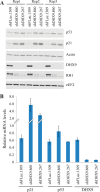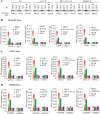Suppression of the DHX9 helicase induces premature senescence in human diploid fibroblasts in a p53-dependent manner
- PMID: 24990949
- PMCID: PMC4132785
- DOI: 10.1074/jbc.M114.568535
Suppression of the DHX9 helicase induces premature senescence in human diploid fibroblasts in a p53-dependent manner
Abstract
DHX9 is an ATP-dependent DEXH box helicase with a multitude of cellular functions. Its ability to unwind both DNA and RNA, as well as aberrant, noncanonical polynucleotide structures, has implicated it in transcriptional and translational regulation, DNA replication and repair, and maintenance of genome stability. We report that loss of DHX9 in primary human fibroblasts results in premature senescence, a state of irreversible growth arrest. This is accompanied by morphological defects, elevation of senescence-associated β-galactosidase levels, and changes in gene expression closely resembling those encountered during replicative (telomere-dependent) senescence. Activation of the p53 signaling pathway was found to be essential to this process. ChIP analysis and investigation of nascent DNA levels revealed that DHX9 is associated with origins of replication and that its suppression leads to a reduction of DNA replication. Our results demonstrate an essential role of DHX9 in DNA replication and normal cell cycle progression.
Keywords: Cell Cycle; Cell Growth; DNA Replication; Helicase; Senescence; p53.
© 2014 by The American Society for Biochemistry and Molecular Biology, Inc.
Figures











Similar articles
-
The Host DHX9 DExH-Box Helicase Is Recruited to Chikungunya Virus Replication Complexes for Optimal Genomic RNA Translation.J Virol. 2019 Feb 5;93(4):e01764-18. doi: 10.1128/JVI.01764-18. Print 2019 Feb 15. J Virol. 2019. PMID: 30463980 Free PMC article.
-
Dependence of p53-deficient cells on the DHX9 DExH-box helicase.Oncotarget. 2017 May 9;8(19):30908-30921. doi: 10.18632/oncotarget.15889. Oncotarget. 2017. PMID: 28427210 Free PMC article.
-
Establishment of a Primary Screening Assay for the DHX9 Helicase.Comb Chem High Throughput Screen. 2015;18(9):855-61. doi: 10.2174/1386207318666151019093433. Comb Chem High Throughput Screen. 2015. PMID: 26477352
-
The biology of DHX9 and its potential as a therapeutic target.Oncotarget. 2016 Jul 5;7(27):42716-42739. doi: 10.18632/oncotarget.8446. Oncotarget. 2016. PMID: 27034008 Free PMC article. Review.
-
Critical telomere shortening regulated by the ataxia-telangiectasia gene acts as a DNA damage signal leading to activation of p53 protein and limited life-span of human diploid fibroblasts. A review.Biochemistry (Mosc). 1997 Nov;62(11):1306-10. Biochemistry (Mosc). 1997. PMID: 9467855 Review.
Cited by
-
Exome Sequencing Reveals Novel Variants and Expands the Genetic Landscape for Congenital Microcephaly.Genes (Basel). 2021 Dec 18;12(12):2014. doi: 10.3390/genes12122014. Genes (Basel). 2021. PMID: 34946966 Free PMC article.
-
The RNA-binding protein PCBP1 modulates transcription by recruiting the G-quadruplex-specific helicase DHX9.J Biol Chem. 2024 Nov;300(11):107830. doi: 10.1016/j.jbc.2024.107830. Epub 2024 Sep 27. J Biol Chem. 2024. PMID: 39342995 Free PMC article.
-
The Host DHX9 DExH-Box Helicase Is Recruited to Chikungunya Virus Replication Complexes for Optimal Genomic RNA Translation.J Virol. 2019 Feb 5;93(4):e01764-18. doi: 10.1128/JVI.01764-18. Print 2019 Feb 15. J Virol. 2019. PMID: 30463980 Free PMC article.
-
DHX9 Strengthens Atherosclerosis Progression By Promoting Inflammation in Macrophages.Inflammation. 2023 Oct;46(5):1725-1738. doi: 10.1007/s10753-023-01836-z. Epub 2023 Jun 16. Inflammation. 2023. PMID: 37326773 Free PMC article.
-
Nucleic acid sensing pattern recognition receptors in the development of colorectal cancer and colitis.Cell Mol Life Sci. 2017 Jul;74(13):2395-2411. doi: 10.1007/s00018-017-2477-1. Epub 2017 Feb 21. Cell Mol Life Sci. 2017. PMID: 28224203 Free PMC article. Review.
References
-
- Hayflick L., Moorhead P. S. (1961) The serial cultivation of human diploid cell strains. Exp. Cell Res. 25, 585–621 - PubMed
-
- Olovnikov A. M. (1971) Principle of marginotomy in template synthesis of polynucleotides. Dokl. Akad. Nauk SSSR 201, 1496–1499 - PubMed
-
- Watson J. D. (1972) Origin of concatemeric T7 DNA. Nat. New Biol. 239, 197–201 - PubMed
-
- Herbig U., Jobling W. A., Chen B. P., Chen D. J., Sedivy J. M. (2004) Telomere shortening triggers senescence of human cells through a pathway involving ATM, p53, and p21(CIP1), but not p16(INK4a). Mol. Cell 14, 501–513 - PubMed
-
- Robles S. J., Buehler P. W., Negrusz A., Adami G. R. (1999) Permanent cell cycle arrest in asynchronously proliferating normal human fibroblasts treated with doxorubicin or etoposide but not camptothecin. Biochem. Pharmacol. 58, 675–685 - PubMed
Publication types
MeSH terms
Substances
Grants and funding
LinkOut - more resources
Full Text Sources
Other Literature Sources
Molecular Biology Databases
Research Materials
Miscellaneous

